Results
Table1:

From the above table1 have the age group of 15 – 20, the frequency is 40, and the percent is 13.3%. However, for the age group of 20 – 30 and 30 – 40, the frequency was 125 and 94 respectively. From this, it was also evidence that the frequency distribution of the two groups would be also greater at 41.7% for the 20 – 30 age grouped person and at 31.3% for 30 – 40 years. Similarly, in the 40 – 50 & 50 – 60 age group people the frequency were 32 and 9, and the frequency distribution of both two groups are 10.7% and 3.0%. The age group of 15 – 20 and 50 – 60 years, the highest and lowest percentage levels of 41.7% and 3.0% were seen.
Table 2:

From the above table 2 showing Male and Female population, for Males the frequency is 139 and the percent is 46.3%. similarly, the Females had the frequency of 161 and the percent was 53.7%.
Table 3:

From the above table 3, the location of East the frequency is 63 and the percent is 21.0%. Similarly, for the West, North, south and Central locations, the frequency was 59, 41, 96 and 41. From this was followed, the percent of all locations are 19.7%, 13.7%, 32.0% and 13.7%. The locations of South, was getting the highest value of percent at 32%, North and Central were getting lower values of percent at 13.7%.
Table 4:

From the above table 4, have the Education levels of Matriculation the frequency level is 10 and the percent was 3.3%. Same pattern, has the Higher Secondary, graduate and Post-Graduate Education of the frequency level is 46, 128, 116. Followed by the pecent levels are 15.3%, 42.7%, and 38.7%. In higher and lower levels of Education the Graduate and Post-Graduate getting higher percents was 42.7% and 38.7%.
Table 5:
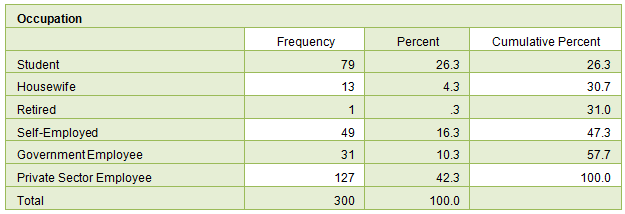
From the above table 5 discussing occupation – for the students, the level of frequency is 79 and the percent was 26.3%. However, the Housewife, Retried, Self-Employed, Government Employee and Private Sector Employee showed frequency levels of 13, 1, 49, 31 and 127 - the percent levels of which were 4.3%, 0.3%, 16.3%, 10.3% and 42.3%. The higher and lower levels were found to be for the Private Sector Employee and Student, with percent levels at 42.3% and 26.3%.
Table 6:
Respondent to Income
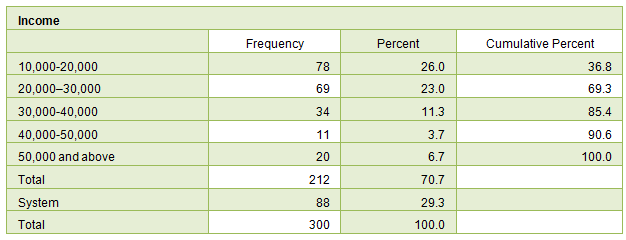
From the above table 6, have the income of 10,000 – 20,000 – the level of frequency is 78 and the percent was 26.0%. The same pattern, has 20,000-30,000, 30,000-40,000, 40,000-50,000 and 50,000 and above showed the frequency level was 69, 34, 11 and 20 follwed by the pecent levels of which were 23.0%, 11.3%, 3.7% and 6.7%. Higher values was found to be for the occupation of 10,000-20,000 by the frequency of 78.
Table 7:

From the above table 7, discusses the Have phoochka(Y/N), for people who did not have phoochka the frequency level 27 and the percent level was 9.0%. Similarly, the participants like to have phoochka frequency level and percentage was 273 and 91.0 respectively.
Graph:
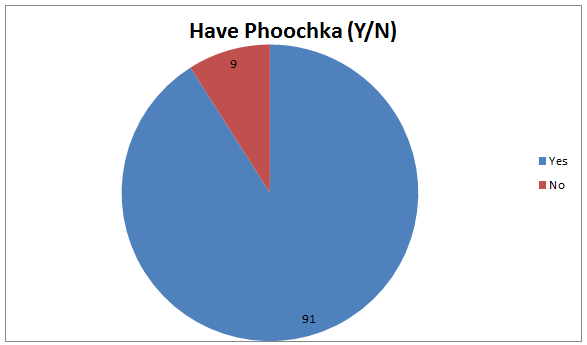
From the above graph, the Have Phoochka yes got the higher level of frequency and precent is 273 and 91.0%
Relationship between Age Group * Have Phoochka (Y/N)
Table 8:

From table above, discusses the relationship between age group and having phoochka. The table reveals that the age group of 50 – 60 years, 100.0% of the participants had Phoochka and the level gradually decreases has a age group decreases. However, the lowest prevelance of having phoochka has noted in 30-40 years of age group has 17.0%, of the respondent revealed that they do not have phoochka and this relationship was significant at p=0.017.
* chi-square value is 12.108 with 4 degress of freedom.
Relationship between Sex * Have Phoochka (Y/N)
Table 9:
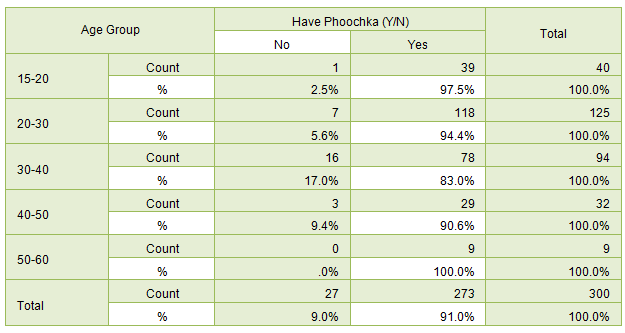
The table above, discusses the relationship between sex and have phoochka. For both male and female have 87.8% and 93.8% had phoochka. Similarly, the male and female participants do not have phoochka the level of percent was 12.2% and 6.2%, and this relationship was significant at p=0.069.
* chi-square value is 3.300 with 1 degress of freedom.
Table 10:
Relationship Between Location * Have Phoochka (Y/N)
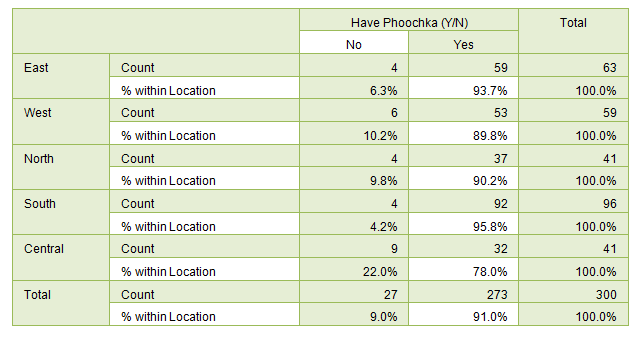
The table above, discusses the relationship between location and have phoochka. In locations of south have 95.8% had phoochka. Similarly, its gradually decreases in Central location it percent was 78.0%.In the locations of central and south getting the higher and lower levels of percent was 22.0% and 4.2% showed that they do not have phoochkaand this relationship was significantly at p=0.019.
* chi-square value is 11.803 with 4 degress of freedom.
Relationship Between Education * Have Phoochka (Y/N)
Table 11:
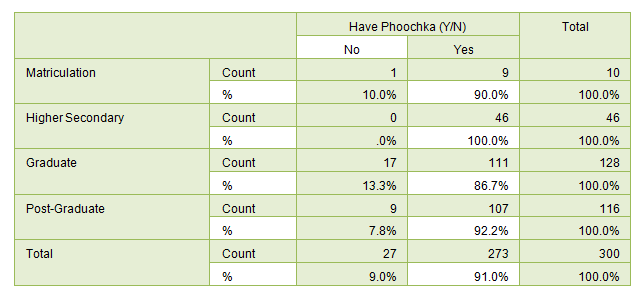
The table above, discusses the relationship between location and have phoochka.The table reveals that the education of Higher Secondary 100.0% of participants had phoochka, and the level of gradually decreases has a education decreases.However, the lowest prevalance of the having phoochka has noted in Graduates of education has 13.3%, of the respondent revealed that they do not have phoochka and this relationship was significant at p=0.054.
* chi-square value is 7.645 with 3 degress of freedom.
Relationship Between Occupation * Have Phoochka (Y/N)
Table 12:
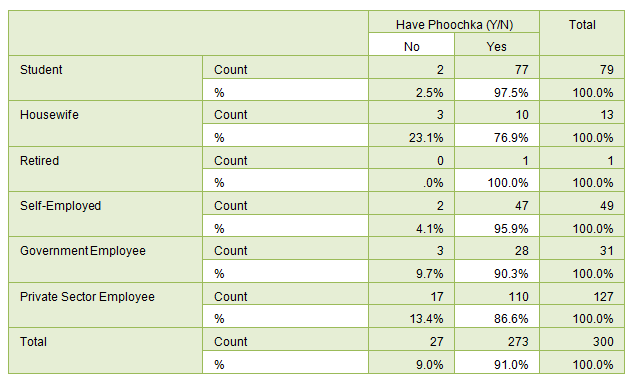
The table above, discusses the relationship between location and have phoochka.The reveals that the retired participants 100.0% had phoochka, and the level gradually decreases has a location decreases. However, the lowest prevelance of having phoochka has noted in 23.1% of the respondent revelead that they do not have phoochka and this relationship was significant at p=0.039.
* chi-square value is 11.728 with 5 degress of freedom.
Relationship between Income * Have Phoochka (Y/N)
Table 13:
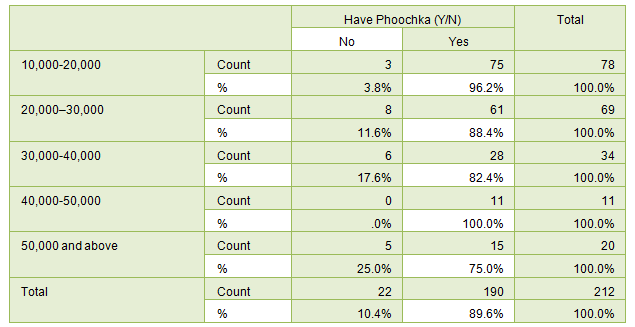
The table above, discusses the relationship between income and have phoochka. The table reveals that the income 40,000-50,000 tye 100.0% of participants had phoochka and the levels gradually decreased has a income decreases. However, the lowest prevelance of having phoochka has noted in 50,000 and above income has 25.0% of the respondent revealed that they do not have phoochka and this relationship was significant at p=0.022
* chi-square value is 11.491 with 4 degress of freedom.
Table 14:

From the above table 14, discusses poochka as snack, for participants had poochka snack the frequency level was 136 and the percentage was 45.3. Similarly, the participants who did not had poochka, the frequency and percentage was 164 and 54.7 respectively.
Table 15:

The table above discusses the frequency of eating. The frequency of participants eating less than 2 times was 182 and the percent 73.4%. Similarly, for those participants between 2-5 times and more than 5 times the frequency was 46 and 20. From this was followed, all others participants the percent level was 18.5% and 8.1%.
Graph:
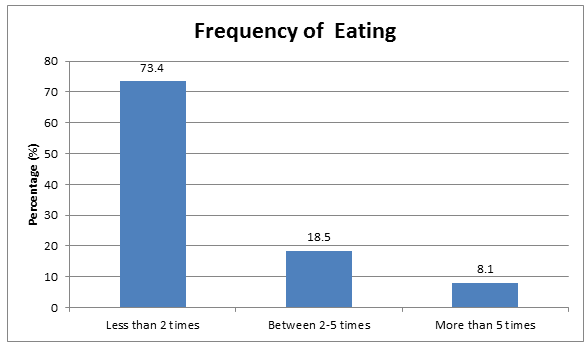
From above graph, the frequency of eating the participants was getting the highest value of percent at 73.4%.
Table 16:

From the above table 16 showing people like phoochka (y/n), for all participants like to have a phoochka the frequency and percentage level was 274 and 91.3%. Similarly, the people do not had phoochka the frequency level 26 and the percent was 8.7%.
Table 17:

The table above, showing the phoochka quality satisfied (y/n).The table revealed that the phoochka quality who do not satisfied, the frequency and the percentage level was 214 and71.3 respectively for people who were not satisfied with phoochka quality. Similarly, the participants who are all satisfied with the phoochka quality, the frequency and percentage was 86 and 28.7 respectively.
Table 18:

From the above table 18 discussing the Current Phoochka price, for the current price of Rs. 10 , the frequency level and the percentage was 99 and 33.7 respectively. However, the current prices of 12, 15, 18 and 20 showed frequency levels of 36, 49, 8 and 102 and percentage of 12.2, 16.7, 2.7 and 34.7 respectively. The higher and lower price levels were found to be 20 and 10 for phoochka with percentage of 34.7 and 33.7.
Table 19:

From the above table 19, have the imported of branded snacks of <=20% the frequency level and the percentage was 0 and 0. Same pattern, has the Between 20% - 50%, Betwen 50% - 70%, 100% and Not at all the imported branded snack, the frequency levels of 106, 145, 29 & 20 and percentage was 35.3, 48.3, 9.7 and 6.7 respectively. The higher and lower levels were found to be between 20% - 70% and <=20% for branded snack with percentage was 48.3 and 0% respectively.
Table 20:

From the above table 20, have the imported of healthy snacks of <=20% the frequency level and the percentage was 23 and 7.7. Similarly, Between 20% - 50%, Betwen 50% - 70%, 100% the imported branded snack, the frequency levels of 33, 157 & 87 and percentage was 11.0%, 52.3% & 29.3% respectively. The higher and lower levels were found to be between 50% - 70% and 20% for imported of healthy snack with percentage was 52.3 and 7.7 respectively.
Table 21:

From the above table 21, discusses poochka from branded store (y/n), for participants had poochka from branded store the frequency level and percentage was 59 and 19.7. Similarly, the participants who did not had the poochka from branded store, the frequency and percentage was 241 and 80.3 respectively.
Table 22:
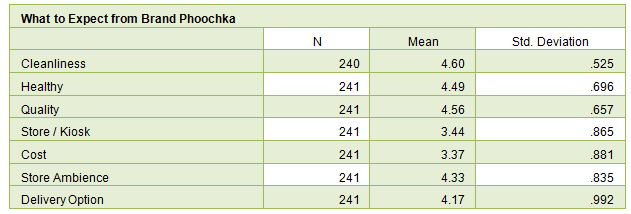
From the above table 22, discusses what to expect from brand Phoochka. The mean of the variable for cleanliness for the particular sample of expect brand Phoochka is 4.60, which is significantly different from the value of 300. Similarly, the mean of the other variables like healthy, quality, store/kiosk, cost, store ambience and delivery option, this are all for the particular samples of brand Phoochka was 4.49, 4.56, 3.44, 3.37, 4.33 & 4.17 and its significantly different from the value of 300 respectively.
Table 23:
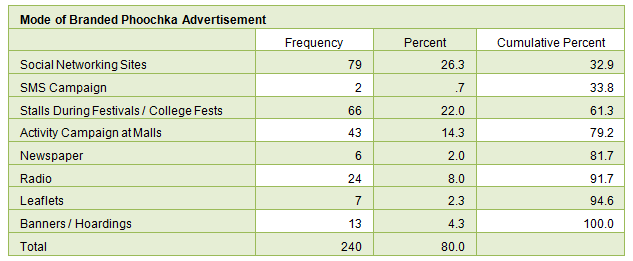
From the above table 23, have the mode of branded phoochka advertisement of social networking sites, the frequency and percentage was 79 and 26.3 respectively. Its was followed by, mode of branded phoochika advertisement of SMS Campaign, Stalls During festivals / College fests, Activity campaignat malls, Newspaper, Radio, Leaflets and Banners / Hoardings the frequency and percentage level was 2, 66, 43, 6, 24, 7 & 13 and 0.7, 22.0, 14.3, 2.0, 8.0, 2.3, & 4.3 respectively. The Mode of branded phoochka advertisement Social Networking and SMS Campaign, got the highest and lowest percentage levels of 26.3 and 0.7 were seen.
Table 24:

From the above table 24, discusses the Flavour in phoochka, the table revealed that the flavours of Classic style phoochka the frequency level and the percentage was 163 and 67.9 respectively. However, the Flavoured phoochka, Phoochka chat style and yoghurt phoochka the frequency and percentage level was 7, 53 & 17 and 2.9, 22.1 & 7.1 respectively. In higher and lower levels of Classic style phoochka and Flavoured phoochka getting higher and lower level percentage was 67.9 and 2.9 respectively.
Table 25:

From the above table 25, discusses the Health important to Phoochka, of Strongly agree the frequency and percentage level was 175 and 58.3 respectively. It followed by the Agree, Undecided and Disagree and above showed, the frequency and percentage level was 112, 10 & 3 and 37.3, 3.3 & 1.0 respectively. The Health important to phoochka of Strongly agree and Disagree was getting the highest the lowest value of percent at 58.3% and 1.0% respectively.
Table 26:

From the above table 26, discussing the Packaged Drinking Water in phoochka, for the participants wanting packaged drinking water in phoochka, the frequency level and percentage was 255 and 85.3 respectively.However, the persons who do not had the packaged drinking water and some people say that does not have matter of the packaged drinking water in phoochka the frequency and the percentage level was 3 & 41 and 1.0 & 13.7.
Table 27:

From the above table 27, discussing the Hygiene in phoochka (Glove usage). The table reveals that the participants wants hygiene in phoochika, the frequency level and percentage was 196 and 66.2 respectively. However, the persons who do not had the hygiene in phoochika and some people says that does not have matter of hygiene in phoochka, if the frequency and the percentage level was 2 & 98 and 0.7 & 33.1 respectively.
Table 28:

From the above table 28, have the Hygiene in phoochka (Mask usage). The table reveals that the participants had hygiene in phoochika (mask usage), the frequency level and percentage was 143 and 47.8 respectively. However, the persons who do not had the hygiene in phoochika and some people says that does not have matter of hygiene in phoochka in mask usage, if the frequency and the percentage level was 21 & 135 and 7.0 & 45.2 respectively.
Table 29:

From the above table 29, have the Max price for 8 piece phoochka of less than Rs.20 the frequency level and the percentage was 77 and 25.8 respectively. Same pattern, has the Between Rs.20 – 30 and Betwen Rs.30 – 50, the frequency and percentage levels of 167 & 54 and 56.0 & 18.1 respectively. The higher and lower levels were found to be between Rs.20 – 30 and between Rs.30 - 50 for maximum price with percentage was 56.0 and 18.1 respectively.
Table 30:
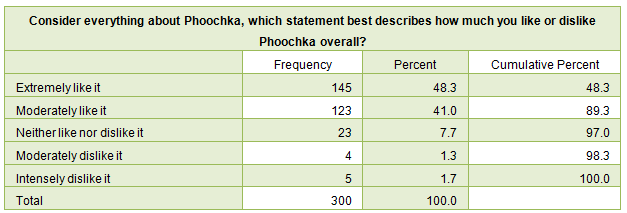
From the above table 30 discussing Consider everything about phoochka, which statement best describes how much you like or dislike phoochka overall? – for the Extermely like it, the frequency and percentage level of 145 and 48.3. However, the Moderately like it, Neither like nor dislike it, Moderately dislike it and Intensely dislike showed frequency levels of 123, 23, 4, and 5 - the percent levels of which were 41.0%, 7.7%, 1.3% and 1.7%. The higher and lower levels were found to be for the Extremely like it and Moderately dislike it, with percent levels at 48.3% and 1.3% respectively.
Table 31:
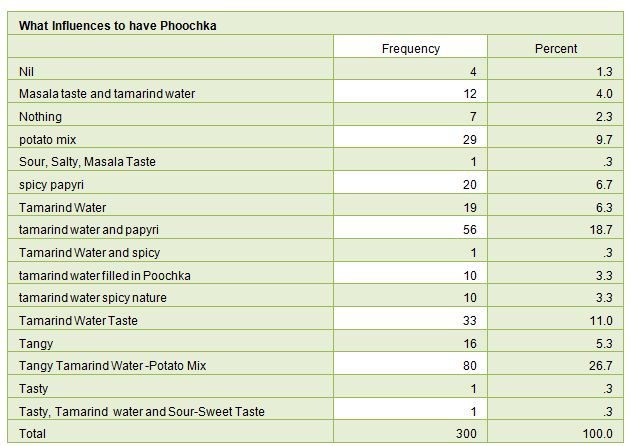
From the above table 31 discussing What influences to have phoochka. The nil level of frequency and percentage was 4 and 1.3% respectively. However, the (Masala taste and tamatind water), (Nothing), (Potato mix), (Sour, Salty, Masala taste), (spicy papyri), (Tamarind water), (Tamarind water and papyri), (Tamarind water and spicy), (Tamarind water filled in poochka), (Tamarind water spicy nature), (Tamarind water taste), (Tangy), (Tangy tamarind water-potato mix), (Tasty) and (Tasty, Tamarind water and Sour-Sweet taste) showed the frequency level of 12, 7, 29, 1, 20, 19, 56, 1, 10, 10, 33, 16, 80, 1 & 1 – the percent level of which were 4.0%, 2.3%, 9.7%, 0.3%, 6.7%, 6.3%, 18.7%, 0.3%, 3.3%, 11.0%, 5.3%, 26.7%, 0.3% and 0.3%. The higher level were found to be for the (Tangy Tamarind Water -Potato Mix) with percent levels at 26.7%, followed by – (Sour, Salty, Masala Taste), (Tamarind Water and spicy), (Tasty) and (Tamarind water and Sour-Sweet Taste) were getting lower values of percent at 0.3%.
Table 32:
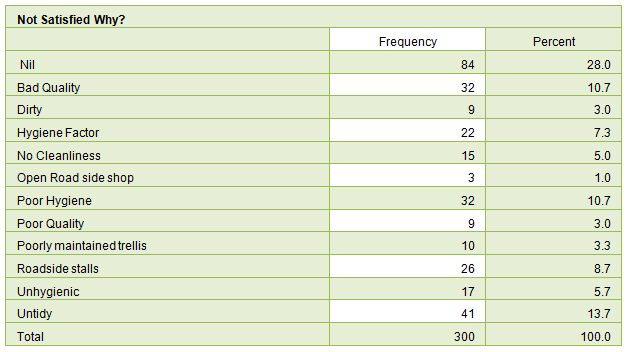
From the above table 32, the participants who never satisfied with phoochka. The nil level of frequency and percentage was 84 and 28.0 respectively. Similarly, Bad quality, Dirty, Hygiene factor, No cleanliness, Open road side shop, poor hygiene, Poor quality, poorly maintained trellis, Roadside stalls,Unhygienic and Untidy - the frequency was 32, 9, 22, 15, 3, 32, 9, 10, 26, 17 and 41. From this was followed, the percent of all not satisfied was 10.7%, 3.0%, 7.3%, 5.0%, 1.0%, 10.7%, 3.0%, 3.3%, 8.7%, 5.7% and 13.7% respectively. The higher and lower levels were found to be for the nil level and open road side shop, with percent levels at 28.0% and 1.0% respectively.


